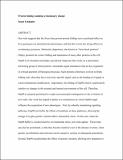Protein Folding Sculpting Evolutionary Change
Author(s)
Lindquist, Susan
DownloadCSHEvolutionChapterLindquist2010.pdf (845.0Kb)
OPEN_ACCESS_POLICY
Open Access Policy
Creative Commons Attribution-Noncommercial-Share Alike
Terms of use
Metadata
Show full item recordAbstract
Our work suggests that the forces that govern protein folding exert a profound effect on how genotypes are translated into phenotypes and that this in turn has strong effects on evolutionary processes. Molecular chaperones, also known as “heat-shock proteins” (Hsps), promote the correct folding and maturation of many other proteins in the cell. Hsp90 is an abundant and highly specialized chaperone that works on a particularly interesting group of client proteins: metastable signal transducers that are key regulators of a broad spectrum of biological processes. Such proteins often have evolved to finish folding only when they have received a specific signal, such as the binding of a ligand or a posttranslational modification. Importantly, the folding of Hsp90 clients is particularly sensitive to changes in the external and internal environment of the cell. Therefore, Hsp90 is uniquely positioned to couple environmental contingencies to the evolution of new traits. Our work has helped to define two mechanisms by which Hsp90 might influence the acquisition of new phenotypes. First, by robustly maintaining signaling pathways, Hsp90 can buffer the effects of mutations in those pathways, allowing the storage of cryptic genetic variation that is released by stress. In this case, when the Hsp90 buffer is compromised by environmental stress, new traits appear. These traits can also be assimilated, so that they become manifest even in the absence of stress, when genetic recombination and selection enrich causative variants in subsequent generations. Second, Hsp90 can potentiate the effects of genetic variation, allowing new mutations to produce immediate phenotypes. In this case, when Hsp90 function is compromised, new traits are lost. These traits can also be assimilated, so that they are maintained under environmental stress, but this is achieved through new mutations. We have discovered these powerful evolutionary mechanisms in fruit flies, mustard plants, and fungi, but expect them to operate in all eukaryotes. Another line of work relating protein folding to the evolution of new traits involves protein-based hereditary elements known as prions. These produce changes in phenotype through heritable, self-perpetuating changes in protein conformation. Because changes in protein homeostasis occur with environmental stress, prions can be cured or induced by stress, creating heritable new phenotypes that depend on the genetic variation present in the organism. Both prions and Hsp90 provide plausible mechanisms for allowing genetic diversity and fluctuating environments to fuel the pace of evolutionary change. The multiple mechanisms by which protein folding can influence the evolution of new traits provide both a new paradigm for understanding rapid, stepwise evolution and a framework for targeted therapeutic interventions.
Date issued
2010-01Department
Massachusetts Institute of Technology. Department of BiologyJournal
Cold Spring Harbor Sym Quant Biol
Publisher
Cold Spring Harbor Laboratory. Press
Citation
Lindquist, S. “Protein Folding Sculpting Evolutionary Change.” Cold Spring Harbor Symposia on Quantitative Biology 74 (2010): 103-108. Web. 3 Nov. 2011. © 2009 Cold Spring Harbor Laboratory Press
Version: Author's final manuscript
ISSN
0091-7451
1943-4456